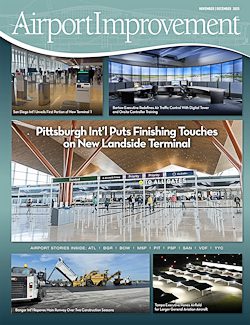Mark Duebner, director of Aviation for Dallas Love Field Airport (DAL), worked for the city of Dallas in various capacities before joining the airport team. (He was even the top civilian commander for the Dallas police.) As he amassed experience in various posts, Duebner developed a strong affinity for cultivating purposefully open and constructive relationships with vendors.
Mark Duebner, director of Aviation for Dallas Love Field Airport (DAL), worked for the city of Dallas in various capacities before joining the airport team. (He was even the top civilian commander for the Dallas police.) As he amassed experience in various posts, Duebner developed a strong affinity for cultivating purposefully open and constructive relationships with vendors.
 As a result, he was willing to listen when the airport’s Wi-Fi service provider (Boingo) approached him about participating in a commercial trial of a newly available spectrum to increase coverage and service while also cutting costs. The project that resulted is a literal manifestation of his firm belief that bilateral communication and cooperation create a culture that gives vendors the latitude to take a chance and make innovative recommendations.
As a result, he was willing to listen when the airport’s Wi-Fi service provider (Boingo) approached him about participating in a commercial trial of a newly available spectrum to increase coverage and service while also cutting costs. The project that resulted is a literal manifestation of his firm belief that bilateral communication and cooperation create a culture that gives vendors the latitude to take a chance and make innovative recommendations.
“At Love Field, we look at contract management in a different way and try not to be adversarial,” he explains. “We don’t want to threaten or penalize our partners; we give them a chance to assess and fix. There are always problems; it’s how you approach those problems that makes the difference. If you’re always quoting the contract, I guarantee you’re not going to have a strong relationship.”
|
facts&figures Project: Commercial Trial of Next-Gen Wireless System Location: Dallas Love Field Airport Wireless Provider: Boingo Cost: No capital outlay for airport Implemented: July 2018 Key Benefits: Cost-effective, secure wireless service; laying groundwork for future developments such as Internet of Things |
Better Connectivity
As DAL approached its 100th anniversary in 2017, officials turned to Boingo to help optimize the airport’s technology roadmap. The Wi-Fi and distributed antenna system provider suggested a proposal to deploy a private Long-Term Evolution (LTE) cellular network on the 3.5 GHz Citizens Broadband Radio Service (CBRS) band. The proposal centered on a commercial trial, the first known CBRS deployment at a major U.S. airport.
Armed with special temporary authority from the FCC, Boingo saw the opportunity to test CBRS, a U.S.-based initiative that dynamically allocates 3.5 GHz on demand in a shared spectrum model. CBRS offers favorable mid-band spectrum for seamless and secure connectivity in dense, high-trafficked areas; and DAL was a solid match for that description. CBRS is also considered more cost-effective than traditional LTE.
“People were begging for more spectrum so the government has looked into making CBRS available,” explains Boingo’s chief technology officer, Derek Peterson, Ph.D. “The FCC realized CBRS had lightly used spectrum available and ready for use. It’s new and everyone is excited about it.”
Fifteen years ago, Wi-Fi wasn’t as ubiquitous in phones, tablets and cameras the way it is today. It took time for the industry to adopt Wi-Fi. Before CBRS becomes mainstream, the device ecosystem has to catch up and roll out products with 3.5 GHz chips that can support the newly deployed spectrum.
Shifting Wireless Needs
In its entirety, DAL has worked with Boingo to implement a private LTE cellular network on the CBRS band, a multi-carrier distributed antenna system (DAS) that boosts cellular service, and Passpoint, a next-gen hotspot technology that automatically connects passengers to Wi-Fi networks without requiring log-ins or passwords. It provides an encrypted connection and includes security features.
Also of note: The CBRS pilot program didn’t require any capital outlay from the airport. All Boingo needed was the cooperation of Duebner and his IT staff.
 “CBRS will allow the airport to save money,” says Peterson. “It’s financially viable, secure and also cost-effective. We need more airwaves like CBRS and more access to them.”
“CBRS will allow the airport to save money,” says Peterson. “It’s financially viable, secure and also cost-effective. We need more airwaves like CBRS and more access to them.”
In 2015, DAL implemented a terminal modernization project. The $500 million program was executed in partnership with Southwest Airlines and upgraded the terminal from top to bottom.
Wi-Fi and a cellular distributed antenna system solution were not in the project budget, but it was becoming clear an upgrade was needed. Instead of trying to increase overall funding, the airport issued a request for proposals to find a company that could create a revenue model to pay for the internet upgrades rather than burning capital outlay. The airport renegotiated an existing contract with Boingo, which was open to the change.
“The revenue sharing model was a good strategy, except the public now expects free Wi-Fi no matter what,” observes Duebner. “We offered 30 minutes free, and then the customer was asked to pay a fee. But constant complaints about having to pay for Wi-Fi were dragging down our customer satisfaction scores.”
Given the changing landscape and growing demands for connectivity from passengers, Boingo rolled out a new free, unlimited Wi-Fi model at DAL. The Wi-Fi experience was upgraded to replace free 30-minute Wi-Fi sessions with free unlimited Wi-Fi access for seamless connectivity throughout the passenger journey.

Wi-Fi, in fact, is still the No. 1 requested passenger amenity, says Danielle Aiello, vice president account management for Boingo. And passengers aren’t the only ones who need the service; concessionaires and the airport itself require fast and reliable connectivity. More connectivity benefits the entire airport ecosystem and provides a key service for visitors with more dwell time.
With the new spectrum in use, DAL’s customer satisfaction scores are going up, quarter after quarter. Moreover, Duebner reports that more than 45% of passengers are connecting through Passpoint.
Net Outcome: Full, Seamless Connectivity
The way many airport officials see it, they have one job—building and maintaining infrastructure to facilitate the movement of people, planes and vehicles. For Duebner, it’s about moving data. Airports have to make it easier for all entities to connect freely within the facility, he stresses.
“I am a believer in operational technology,” says Duebner. “As the Internet of Things expands and we look at devices we want to deploy in every aspect of our business, we can move to levels of technology in which everything becomes a smart device. This improves the efficiency of our human capital.”
CBRS offers the airport opportunities to augment coverage and capacity without the interference and congestion that often frustrates passengers. With the newly available spectrum, the management team can conduct private communications for employees and passengers without interrupting the public side, and vice versa. Additionally, Duebner foresees the use of more Internet of Things devices and sensors, which will give the airport more agility.
Boingo personnel note that their company believes in network convergence that leverages licensed, unlicensed and shared spectrum within large public venues, like DAL. This means that in the future, a wireless network at DAL may allow users to transition from cell service (LTE or 5G) boosted by a DAS (distributed antenna system) to Boingo Passpoint (Wi-Fi) to the CBRS spectrum. That’s a lot of acronyms! Basically, the intent is to reduce friction points for airport visitors and create full connectivity from the moment they arrive at the curb. Furthermore, visitors don’t experience transition hops, because the handoffs are designed to be seamless and highly secure.
“CBRS allows more segmentation and is more secure,” says Peterson. “Traditional LTE offers encryption through a device. Wi-Fi can, too, if you’re using Passpoint. But if you’re not using Passpoint, anyone could walk in with their phone, ask it to broadcast the SSID, connect to someone else’s laptop and do a ‘man in the middle attack’, siphoning data via spoofing.”
Maintaining Administrative Control
Boingo is in a neutral host position to solve wireless problems for the airport, and company officials consider everyone who walks into the terminal a customer, plus the venue itself, airport tenants and air carriers. Balancing the commercial needs for all users is its charter, says Peterson. The airport made the decision to—as Duebner describes it—“benevolently manage” the system for all players, and Boingo shepherds users under that umbrella.
“We made a decision when we built the new airport that all infrastructure was going to be under the jurisdiction of the airport,” explains Duebner. “We have held the line, not allowing other parties—airlines, concessions and so on—to build out their own. I think that’s really important, especially as we get more crowded on the spectrum. We have been very conscious about maintaining control so we don’t have those problems, and we’re trying to stay ahead of the game.”
Currently, DAL is focused on making the right decisions for its team and is fully willing to shamelessly copy good ideas from other airports, jokes Duebner.
“Our neighbor DFW is a great airport, and it has been in the forefront of a lot of technology deployment,” he adds. “They take the lead and pass the lessons on to the industry. It’s important to me to learn from past experiences and be honest. As an industry, we shouldn’t all be making the same mistakes. We can be creative.”
That said, some areas of DAL do not have coverage with CBRS. “To me, we need to get this technology and others that are even broader down on the ramp area and in the back offices, where we don’t have coverage now,” says Duebner. “When we move to a real Internet of Things, that’s where we want to head, so that everywhere in our facility, including the ramp and outbuildings, are linked.
“Connectivity solves an operational need,” he concludes. “And it’s coming in the very near future.”



